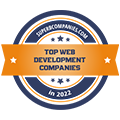Website coding generally entails server-side coding, client-side coding, and database technology. However, the programming languages implemented to deliver dynamic website content vary vastly among sites.
Website coding generally entails server-side coding, client-side coding, and database technology. However, the programming languages implemented to deliver dynamic website content vary vastly among sites.
In the last few years, the web has persisted in evolving, and some distinct streams of website coding have emerged. Today, websites are like the heart of internet by being 1 billion in number.
With respect to coding, There are 3 main types of website coding. Front-end website coding is referred to as client-side. In addition, it offers the part of the web that the person interacts with. Back-end website coding (or server-side website coding) offers all the matters that run within the background to make websites or web apps work, like databases and scripts. Then there are full-stack web developers, who can do all of the above.
Regardless of which direction you pick to go down, you’ll still want to apprehend every side that allows you to do your activity properly. So here is a detailed account of frameworks and technologies of/for website coding. It will be amply beneficial for creating your web app to know about each type.
Front End website coding
1. JavaScript coding
JavaScript is the primary client-side programming language for any sort of website coding for web development. Almost 100% of web developers use JavaScript for incorporating client’s behavioral preferences into their website or web application.
This is due to the fact JavaScript permits developers to create dynamic websites. Basic functionality like scrolling bars and clickable buttons are highly strong points of JavaScript programming. Since JavaScript’s twentieth-century origins, the language has evolved greatly, demonstrating its variability via its many use cases and frameworks.
2. HTML coding
Hyper Text Markup Language (HTML) is another important technology for website coding. HTML is liable for structuring the content material of a web page. A collection of HTML elements describe a web page, a way to show text, images, and the trendy version of HTML, “HTML 5” audio and video as well. HTML elements are generally recognizable through the “<” and “>” characters.
Here’s a tip: if you’re on a computer or laptop, right-click on any web page, press “View web page source” and you may discover a bunch of HTML embedded codes right into your browser.
3. CSS
Cascading Style Scripts (CSS) is a language for denoting the presence of a web page. Just like JavaScript and HTML, it is a basic technology making the World Wide Web what it is today.
Colors, layouts, and fonts are a number of vital traits of a web page or web app and CSS invokes those traits.
Back-End website coding
Back-end development functions a much wider variety of technology as back-end website coding accommodates numerous components that include server-side programming, databases, web servers, and APIs.
1. Programming languages
Server-side or back-end website coding programming languages have to deal with the functionality of a web app that takes place in the back of the scenes. Back-end web development can involve operating with databases to send and obtain records from one end to the other, handling user connections and protection authentications, eventually, empowering the web application to execute as it should.
Java, Python, Ruby, and PHP are a number of famous back-end coding languages. Many tech agencies use more than one of these languages however, many side-by-side comparisons exist to have a look at their utility. There are also back-end web frameworks to simplify software program development. Django and Ruby on Rails are becoming more and more famous in the web development community in this regard.
2. Data bases
Databases keep the records of an application. Back-end developers have to be acquainted with query languages that are be able to request and retrieve records through the use of queries.
Structured Query Language (SQL) is the go-to query language for web developers. SQL has many extensions or associated versions extending extra capabilities like MySQL, PostgreSQL, and Oracle.
3. Servers websites coding
Servers respond to network requests. Through the net connection of a web application, a server retrieves data primarily based on consumer requests after which it serves the consumer. That is you, your computer, or your cell device. Anything it is which you requested for.
Generally, there isn’t a particular language for servers. All the technology and website coding that makes up back-end development must have a great relationship with the servers they work with. Web servers of note consist of Apache, Nginx, and Internet Information Services (IIS).
4. API’s website coding
APIs facilitate connections among 2 or more software program systems. API integration is what fuels your Google Home’s communique along with your Spotify playlist, for instance, or eBay’s collaboration with PayPal.
Again, APIs no longer have a domain-precise language. Instead, builders create APIs with the use of different back-end technologies and share them publicly with different builders or maintain them close to the enterprise they work for.
Web apps come with great benefit of a combination of front-end website coding and back-end website coding, along with software program development techniques. It is sure that website coding will undergo ground-breaking changes with time that will prove highly benefitting for all of us in the field.
BACK










